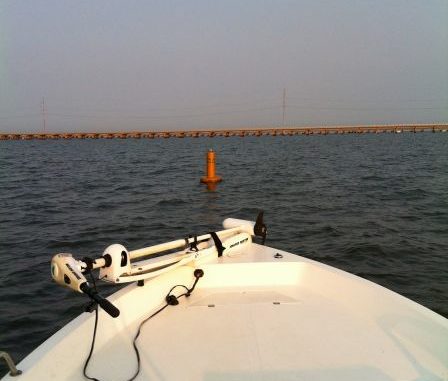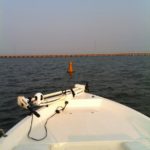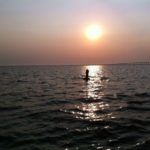
Want to get away from the crowds? Head for the Lake Pontchartrain reefs, and catch boatloads of fish.
I watched what seemed to be an unending parade of barges filled with mountains of crushed concrete arrive and dump their contents onto the lake floor to create a five-acre artificial reef, all from the back porch of my home on Lake Pontchartrain’s Northshore.
This new reef, near the train tressel in eastern Lake Pontchartrain, would join several other artificial reefs scattered across the lake serving as prime fish-holding habitat.
Several months later, I found myself anchored downcurrent from this underwater rock pile, tossing live shrimp under a sliding cork rig in hopes of catching some nice specks.
Best of all, I was all alone, while just a short distance away was a flotilla of anglers lining the train trestle from one shoreline to the other.
Just as my mind began to wander, I was snapped back to reality as my cork began to move sideways and slipped under the surface as yet another trout engulfed the shrimp and then erupted on the water’s surface in an effort to throw the hook.
The creation of artificial reefs is one of the many programs that the Lake Pontchartrain Basin Foundation has been involved in to increase the value of the lake for recreational fishing.
In order to better understand the work that the foundation is doing, I spoke with its executive director, John A. Lopez.
“The initial planning for the artificial reef program began back in 1997 and 1998,” Lopez said. “After discussions involving the location and the type of material to use, the first reef was created in 2000 near the Lakefront Airport and consisted of limestone rubble at a cost of about $60,000.”
That first reef was followed by a series of additional reefs that were constructed from reef balls at a cost of about $20,000 each.
“The reefs consist of between 150 and 200 reef balls that range from 2 to 3 feet tall and are about 4 feet wide at the base,” Lopez said.
Lopez said these reefs are different from other habitat along the coast.
“The reefs in the lake are different from typical reefs found in the Gulf and other marine locations: The water is very brackish in the lake, and reefs do not have oysters or coral growing on them,” he said. “Instead, you will find barnacles, sponges and algae that form the base that attracts game fish and other species.
“In recent sampling studies, 59 different species of marine life were found on these reefs including 30 species of fish.”
The two most-recent artificial reefs have been placed in eastern Lake Pontchartrain. These reefs were made from demolition concrete from the old I-10 twin spans.
The first reef was constructed in 2011 near the south shore between the Highway 11 bridge and the I-10 twin spans.
The second reef, named the Dudley and Kim Vandenborre Reef, is north of the first reef near the north draw of the Highway 11 Bridge.
These reefs have great potential because they are located in an area that already holds plenty of game fish, and the reefs rise 6 to 8 feet in the water column, which is higher than the other reefs.
These new reefs are already producing excellent fishing opportunities. Because the lake bottom is basically a homogeneous topography, any bottom structure that creates a feature will naturally attract marine organisms and, in time, will create its own eco-system that will attract and hold game fish such as speckled trout, white trout, redfish, flounder, black drum, sheepshead, croaker and other species.
While biology has its place in attracting the fish, learning how to catch them is what most anglers are interested in.
There are a few basic techniques that will greatly increase the success of anglers wanting to fish artificial reefs.
To learn these techniques, we asked several veteran lake experts to share some of their tips. Capt. Kenny Kreeger of Pontchartrain Charters, Chas Champagne of Dockside Bait and Tackle and Capt. Greg Schlumbrecht were kind enough to share their thoughts on fishing the artificial reefs in the lake.
Here are some of those tips.
The best reefs to try
The artificial reef near Bayou Lacombe is a favorite of both Kreeger and Champagne.
“The Bayou Lacombe reef is a pretty good bet,” Champagne said. “It sits right between the two Bayou Lacombe gas rigs and holds lots of fish.”
Kreeger said age is part of the equation making this reef especially productive.
“The Bayou Lacombe reef has been around for a while, and has a lot of aquatic growth on it and it is very productive,” he said.
And the sweet part of this structure is that if it does not produce, you can also try the gas rigs that are close by.
Champagne also really likes the reefs off of Williams Boulevard on the western side of the lake, especially for big trout.
“If you really want some nice trout, try the Williams Boulevard reefs,” he said. “I caught some of the best stringers of trout in my life there.”
When asked about the two new reefs on the eastern side of the lake, Kreeger said he’s biding his time.
“Those reefs are pretty new and I have not had much luck on those yet, but I see a few boats there consistently so they must be catching a few,” he said. “I am looking forward to fishing these reefs once they mature a little more.”
Locating the reefs
See the sidebar for a list of GPS coordinates to the Lake Pontchartrain rigs, but the only reefs marked with buoys are the two newest ones in eastern Lake Pontchartrain.
For the others, Capt. Greg Schlumbrecht suggests using your GPS to get in the right vacinity and then using your trolling motor and depth finder to pinpoint the exact location of the reef.
“Don’t go barreling in with the outboard and scare all the fish away as you approach,” Schlumbrecht said. “Use you trolling motor; then pick a spot to anchor.”
Wind, tides and current
The next order of business, once at the reef, is determining the flow of the water around it. Current is created by both tides and wind.
According to Schlumbrecht, the fish will normally be staged at predictable points on the reef.
“Most of the time the bite will be downcurrent from the reef, but not always,” he said. “You should try several different locations around the corners of the reef to find a pattern.
“Once you catch a few, stay on that pattern.”
Kreeger believes that the optimal tidal range for the lake is between .6 and 1.2 feet.
Both incoming and outgoing tides produce fish, Kreeger said.
“The tide has to be moving,” he said.
Light to moderate winds are necessary to fish the lake, but anything over 10 knots makes fishing difficult.
Any wind direction except for west is fine.
Baits and tackle
When fishing the reefs, it is difficult to fish close to the bottom where the fish are staged without getting snagged constantly.
The solution recommended by Champagne is a sliding-cork rig.
“A sliding-cork rig can be adjusted to fish any depth and allows for easy casting (see sidebar),” he said. “When you fish these reefs, you have to get close to the bottom without getting snagged.”
He said he uses the current to put his bait in the right position.
“I like to throw upcurrent and watch the cork drift with the current, letting line out as it drifts,” Champagne said. “Pay attention to where you are getting the bites, and then reposition the boat if necessary to properly fish the area holding fish.”
Kreeger likes to set the sliding cork at about 6 inches from the bottom, and he moves it up a little at a time until he stops getting snags.
Live bait, when available, is always a good bet. Live shrimp are the most readily available, and Dockside normally has plenty of them.
Fresh market bait will also work if live bait is not available.
Number 6 treble hooks seem to be the best choice for fishing live bait in the lake and not missing many bites.
Artificial baits also produce fish, but make sure to keep the lure moving to avoid hang-ups and bring plenty of jigheads.
Champagne likes Matrix lures, and Kreeger uses the new Category 5 plastic baits.
Techniques
I have found that, when using a sliding cork, the best technique is to cast upcurrent and letting the bait drift back with the current naturally. When the bait reaches the end of the drift, reel it in and toss it back up current.
When you see the cork start to move sideways, get ready, but do not set the hook until the cork is under and the slack is out of the line. Do not be in a hurry.
Give each spot about 10 or 15 minutes, and then move to another location on the reef.
But be sure to work the corners well.
“Make sure to thoroughly fish all corners of the reef before moving on,” Schlumbrecht said.
This story’s sources can be reached: Capt. Kenny Kreeger, Pontchartrain Charters, 985-960-3068; Chas Champagne, Dockside Bait and Tackle, 985-707-2103; Capt. Greg Schlumbrecht, To Fish Charters, 985-960-1709; Capt. Steve Himel, Marshland Adventures, 504-458-8737.


